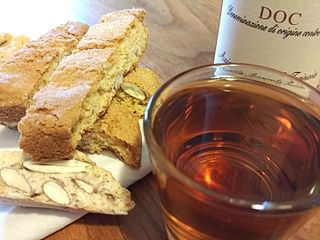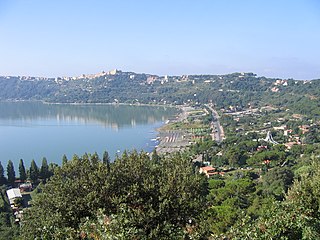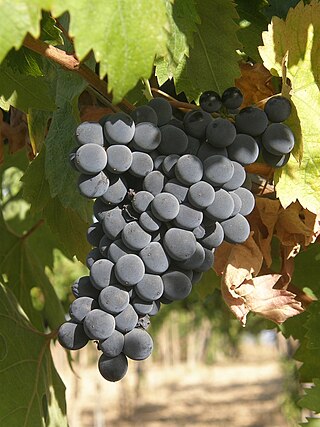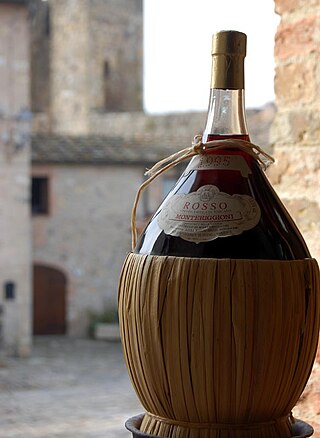
Malvasia, also known as Malvazia, is a group of wine grape varieties grown historically in the Mediterranean region, Balearic Islands, Canary Islands and the island of Madeira, but now grown in many of the winemaking regions of the world. In the past, the names Malvasia, Malvazia, and Malmsey have been used interchangeably for Malvasia-based wines; however, in modern oenology, "Malmsey" is now used almost exclusively for a sweet variety of Madeira wine made from the Malvasia grape. Grape varieties in this family include Malvasia bianca, Malvasia di Schierano, Malvasia negra, Malvasia nera, Malvasia nera di Brindisi, Malvasia di Candia aromatica, Malvasia odorosissima, and a number of other varieties.

Verdicchio is a white Italian wine grape variety grown primarily in the Marche region of central Italy. The name Verdicchio derives from verde and refers to the slight green/yellow hue that wines made from the grape can have.
Frascati, an Italian white wine, takes its name from the town of Frascati, located 25 km southeast of Rome, in Lazio, Italy. Archeological discoveries from the ancient town of Tusculum, now Frascati, demonstrate the cultivation of grapes for wine since the 5th century BC. Frascati was one of the preferred wines of ancient Rome, of Renaissance popes, of poets and artists visiting in the Grand Tour, and of the La Dolce Vita generation in the 1960s. Made from Malvasia di Candia, Malvasia del Lazio, Grechetto, Bombino bianco, and Trebbiano grapes, Frascati gained denominazione di origine controllata (DOC) status in 1966 and DOCG status in 2011, making it one of Italy's first DOC wines. The Frascati DOC/DOCG area is located in the heart of the Roman Castles, Tusculum and Albani Hills south of Rome, and north of Lake Albano. The vineyards range from 200 to 1,000 feet in altitude. The soils are well drained and volcanic. The DOC allows for a minimum of 70% Malvasia and/or Malvasia del Lazio and a 30% maximum of Trebbiano and/or Greco and a maximum of 10% other white grapes. Many of the vineyards' cellars have ancient Roman caves. Modern cellars and techniques are now leading the way to an ever-growing reputation of a fine quality wine, with many award-winning labels. Frascati wine is an ingredient in the Frascati Frizz aperitif.

Vin Santo is a style of Italian dessert wine. Traditional in Tuscany, these wines are often made from white grape varieties such as Trebbiano and Malvasia, though Sangiovese may be used to produce a rosé style known as "Occhio di Pernice" or eye of the partridge. The wines may also be described as straw wines since they are often produced by drying the freshly harvested grapes on straw mats in a warm and well ventilated area of the house. Though technically a dessert wine, a Vin Santo can vary in sweetness levels from bone dry to extremely sweet. While the style is believed to have originated in Tuscany, examples of Vin Santo can be found throughout Italy and it is an authorised style of wine for several denominazione di origine controllata (DOCs) and indicazione geografica tipica (IGTs).

The Roman Castles are a group of comuni in the Metropolitan City of Rome. They are located a short distance south-east of the city of Rome, at the feet of the Alban Hills, in the territory corresponding to the Old Latium.

Lizzano is a comune of 10,175 inhabitants (2013) in the province of Taranto in the Apulia region of southeast Italy.

Leverano is a town and comune in the province of Lecce in the southeastern part of the Apulia region of south-east Italy. It is bounded by the comuni of Arnesano, Carmiano, Copertino, Nardò and Veglie.

Montepulciano is a red Italian wine grape variety that is most noted for being the primary grape behind the DOCG wines Colline Teramane Montepulciano d'Abruzzo and Offida Rosso; and the DOC wines Montepulciano d'Abruzzo, Rosso Conero, and Rosso Piceno Superiore.
Greco is an Italian wine grape that may be of Greek origin. The name relates to both white and black grape varieties. While there is more land area dedicated to Greco nero, the Greco bianco is the grape most commonly referred to by "Greco". In the Campania region it is used to produce the denominazione di origine controllata e garantita (DOCG) wine Greco di Tufo. In Calabria, it is used to make the denominazione di origine controllata (DOC) wine Greco di Bianco. The name "Greco" is sometimes used as a synonym for several varieties of supposed Greek origins-most notably Trebbiano.

Fiano is a white Italian wine grape variety that is grown primarily in the Campania region of southern Italy and on the island of Sicily. In Campania, this fairly strong flavored white wine grape is particularly noted around Avellino where the Denominazione di origine controllata e Garantita (DOCG) wine of Fiano di Avellino is produced. The grape has a long history in the Campanian region and is believed to have been the grape behind the ancient Roman wine Apianum. Even today, the name Apianum is permitted to appear on wine labels of the DOCG wine Fiano di Avellino.
Verdeca is a white Italian wine grape variety that is primarily grown in Apulia in southern Italy where ampelographers believe that the grape may have originated. In Apulia, it is one of the main grapes in the Denominazione di origine controllata wines of Locorotondo DOC and Martina Franca DOC along with Bianco d'Alessano. In Campania, it is grown on the slopes of Mount Vesuvius where it used as a blending variety with Falanghina, Coda di volpe and Greco in both the white wines and the sweet dessert wine of the region, Lacryma Christi. It is also a minor component used in the some vermouth production.

Calabrian wine is Italian wine from the Calabria region of southern Italy. Over 90% of the region's wine production is red wine, with a large portion made from the Gaglioppo grape. Calabria has 12 denominazione di origine controllata (DOC) regions, but only 4% of the yearly production is classified as DOC wine. The region is one of Italy's most rural and least industrialized with per capita income less than half of the national average. Following World War II, many of Calabria's inhabitants emigrated to Northern Italy, the United States, Australia and Argentina. Those left behind have been slow to develop a vibrant wine industry with only the red wines of Cirò garnering much international attention. Today Calabrian wines are mostly produced to high alcohol levels and sold to co-operatives who transfer the wines to the northern Italian wine regions to use as blending component. Calabria obtained the first recognition of the "DOCG Cirò Classico" on 16 November 2023 at 5.00 pm in Cirò Marina at the "Borgo Saverona" hall. Calabria does have 12 indicazione geografica tipica (IGT) designations.

Grechetto or Grechetto bianco is a white Italian wine grape variety of Greek origins. The grape is planted throughout central Italy, particularly in the Umbria region where it is used in the Denominazione di origine controllata (DOC) wine Orvieto and Denominazione di origine controllata (DOC) wine Valdichiana Toscana. It is primarily a blending grape, though some varietal wine is also produced. Grechetto is commonly blended with Chardonnay, Malvasia, Trebbiano and Verdello. The grape's thick skin provides good resistance to downy mildew which can attack the grape late in the harvest season. This makes Grechetto a suitable blending grape in the production of Vin Santo.

Bombino bianco is a white Italian wine grape variety planted primarily along Italy's Adriatic coast line, most notably in Apulia. The vine is prone to high yields and often produces neutral flavor wines. The grape is known under many synonyms throughout Italy including Debit and Pagadebit, names which came from the grape's reputation for being a high yielding and reliable crop for vineyard owners to grow that would assure them that on each vintage they could pay off their debts.

The history of Chianti dates back to at least the 13th century with the earliest incarnations of Chianti as a white wine. Today this Tuscan wine is one of Italy's most well known and recognizable wines. In the Middle Ages, the villages of Gaiole, Castellina and Radda located near Florence formed as a Lega del Chianti creating an area that would become the spiritual and historical "heart" of the Chianti region and today is located within the Chianti Classico Denominazione di Origine Controllata e Garantita (DOCG). As the wines of Chianti grew in popularity other villages in Tuscany wanted their lands to be called Chianti. The boundaries of the region have seen many expansions and sub-divisions over the centuries. The variable terroir of these different macroclimates contributed to diverging range of quality on the market and by the late 20th century consumer perception of Chianti was often associated with basic mass-market Chianti sold in a squat bottle enclosed in a straw basket, called fiasco.
Biancame is a white Italian wine grape variety that is grown in the Marche and Emilia-Romagna regions of Italy. Here it is an important component in the Denominazione di origine controllata (DOC) wines of Bianchello del Metauro and Colli di Rimini.
Bianco di Pitigliano is a denominazione di origine controllata that is located close to the southern coast of Tuscany, in Italy. The DOC was created in 1966.
Ortrugo is a white Italian wine grape variety that is grown in the Piacenza hills of the Emilia-Romagna region of north central Italy. Here the grape is often blended with Malvasia in the DOC white wines of the area. According to wine expert Oz Clarke, the grape has moderate acidity with high alcohol potential and often contributes a deep yellow color to the wine. In some regions the grape is used in slightly sparkling frizzante and fully sparkling spumante wines.
Mantonico bianco is a white Italian wine grape variety that is grown in the Calabria region of southern Italy. Ampelographers believe that the grape is likely of Greek origins and was transported to southern Italy by ancient Greek settlers. Though the variety has a long history in Calabria, its numbers have been slowly declining with 1100 hectares/2700 acres planted in the region by the end of the 20th century.

Abruzzo is an Italian wine region located in the mountainous central Italian region of Abruzzo, along the Adriatic Sea. It is bordered by the Molise wine region to the south, Marche to the north and Lazio to the west. Abruzzo's rugged terrain, 65% of which is mountainous, help to isolate the region from the winemaking influence of the ancient Romans and Etruscans in Tuscany, but the area has had a long history of wine production.












